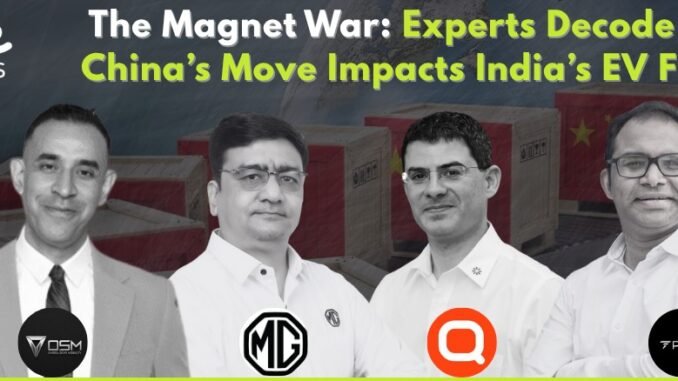
A Crisis Ignited by Geopolitics
In April 2025, China tightened export controls on rare earth magnets—critical components for electric vehicle (EV) motors—triggering a supply chain crisis for India’s booming EV sector. With China controlling 90% of global rare earth magnet processing, India’s dependency has left its automakers scrambling. The immediate fallout is stark:
- 53,700 tonnes of permanent magnets were imported in FY2025, with over 90% from China.
- 15-20 Indian component manufacturers face paralysis without Chinese approvals, risking a production freeze across e-bikes, scooters, and trucks.
- Maruti Suzuki slashed near-term EV production targets by two-thirds, citing rare earth shortages.
Ravin Mirchandani, Chairman of Quench Chargers, warns: “China’s near-monopoly isn’t just economic—it’s a geopolitical lever. Without government intervention, chaos looms within months.”.
Faced with an existential threat, Indian automakers are scrambling to keep production lines running—but their stopgap measures reveal deeper vulnerabilities.
Industry on the Brink: Short-Term Survival Tactics
Indian companies are adopting stopgap measures to avoid production halts:
- Strategic Stockpiling: MG Motors and Tata Motors are building reserves, but inventories will last only 2–3 weeks.
- Contingency Imports: Some OEMs are importing fully assembled motors from China, risking PLI scheme eligibility due to reduced local value addition.
- Diplomatic Push: The Society of Indian Automobile Manufacturers (SIAM) is negotiating with Chinese authorities to fast-track 30+ pending export licenses.
Sameer Jindal of MG Motors highlights the dilemma: “Every EV segment is exposed. Even homologation tweaks for imported motors won’t save us if China delays approvals.”
While companies fight fires today, industry leaders agree: long-term survival demands radical innovation.
Long-Term Solutions: Reengineering and Recycling
To break free from dependency, industry leaders advocate structural shifts:
- Rare Earth-Free Motors: Omega Seiki’s Uday Narang reveals: “We switched to induction motors years ago. Our production remains stable while others panic.”.
- Magnet Recycling: Nishant of PURE Energy emphasizes “urban mining” from e-waste, which could meet 15–20% of India’s demand by 2030.
- Domestic Processing: India Rare Earths Ltd. plans a Hyderabad plant to produce 500 tonnes of magnets annually by 2026, scaling to 5,000 tonnes by 2030.
However, Ravin Mirchandani cautions: “These fixes take 1–3 years. Without urgent government deals, the sector faces a cliff.”.
The clock is ticking—and the government’s role in bridging this gap is now under scrutiny.
Government Steps In: PLI Schemes and Strategic Reserves
The Indian government is rolling out multi-pronged measures:
- PLI 2.0: A ₹3,000-crore scheme to produce 4,000 tonnes of rare earth magnets domestically by 2035.
- Stockpiling Initiative: Talks with automakers to create national reserves, backed by fiscal incentives.
- Diplomatic Outreach: The Indian Embassy in China is pressing for transparent licensing to avoid July production halts.
Yet, challenges persist. India’s current rare earth processing capacity is 3 tonnes/year versus 3,600 tonnes imported.
As India scrambles domestically, the global fallout from China’s moves is reshaping alliances.
Global Fallout: New Alliances Emerge
China’s restrictions are reshaping global trade dynamics:
- Quad Collaboration: India partners with the US, Japan, and Australia on joint mining ventures and R&D.
- EU Recycling Push: Brussels is accelerating rare earth recycling to cut reliance on Chinese imports.
- Atmanirbhar Bharat Boost: Modi’s self-reliance drive targets 6% of global rare earth reserves trapped in uranium-linked deposits.
Nishanth Dongari notes: “This crisis is fast-tracking partnerships with Japan and the US. It’s a race for mineral independence.”
The path forward is clear—but fraught with hard choices.
The Road Ahead: Innovation or Capitulation?
The path forward hinges on three priorities:
- Immediate: Secure Chinese approvals while stockpiling.
- Medium-Term: Scale recycling and launch magnet PLI schemes.
- Long-Term: Invest in R&D for alternative materials like iron nitride.
Sameer Jindal warns: “China’s price cuts could undermine our efforts. Their magnets cost $52/kg—half our projected rates.”.
Our Take
India’s rare earth crunch is a wake-up call. While short-term disruptions threaten growth, they’re spurring overdue reforms. With bold policies and private-sector innovation, this crisis could catalyze a self-reliant EV ecosystem. The choice is clear: adapt now or cede the clean energy race to China.






